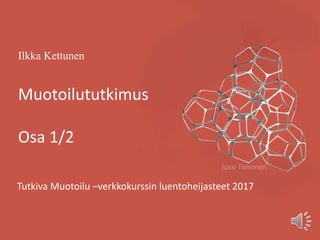Muotoilututkimus1(2) heijasteet 2017
- 1. Ilkka Kettunen Muotoilututkimus Osa 1/2 Tutkiva Muotoilu ŌĆōverkkokurssin luentoheijasteet 2017 Jussi Timonen
- 2. ŌĆó How do designers make sense of the design process? ŌĆó How do designers create opportunities for other stakeholders to participate in the creative process?
- 3. Design process individual - centered collaborative reflectiverational design hero bricoleur participatory, situated,ŌĆ”dominant tehcno-rational
- 5. Tolkun tekeminen: 1) perustuu identiteetin rakentamiseen 2) katsoo menneeseen 3) toimii ymp├żrist├Č├ż tuottavasti 4) kohdistuu havaintoihin, jotka tukevat menneisyyden kokemuksia 5) vakuuttavuus t├żrke├żmpi kuin paikkansa pit├żvyys 6) on sosiaalista 7) on jatkuvaa (Weick 1995)
- 8. a) Identiteetti luo tuotteen ŌĆō muotoile identiteetti├ż b) Aloitetaan sill├ż mit├ż meill├ż on (vs. kausaalinen) c) Tekemisen kautta ŌĆō pieni├ż kokeiluja, vetoja d) Innovatiivisuutta k├żyt├żnt├Čihin (tiedostaminen) e) Jokainen tk-tilanne ja ŌĆōprosessi omanlaisensa f) Luodaan positiivinen illuusio ŌĆō itsepetos jopa? g) Kaikki muotoilee yhdess├ż ŌĆō johtajista k├żytt├żjiin h) Sis├żll├Čn annetaan muovautua koko ajan
- 9. Analytic autoetnograpy (Anderson 2006) Researcher is: 1. a full member in the research group. 2. visible as such a member in published texts. 3. committed to developing theoretical understandings of boarder social phenomena.
- 10. Context ŌĆó EDUFIX ltd. (pseudonym) ŌĆó Furniture manufacturing (fictious) ŌĆó 300 empoyees, 400 MŌé¼ sales, 70% exported ŌĆó R&D venture: intelligent learning environment ŌĆó Informants: designers, managers, researchers, engineersŌĆ”
- 11. Data ŌĆó Diary ŌĆó Videos of design group + management board meetings ŌĆó 1600 sketchs, ŌĆ”
- 12. Story ŌĆó Autoetnography narrative, 60 pages. ŌĆó Duration 10 months ŌĆó Designing 16 product concepts ŌĆó Starting from the first meeting with the management board ŌĆó Ending up handing over the concepts for detail design ŌĆó Plot: enthusiasm, frustration, successŌĆ”
- 13. Analysis / Interpretation 1st order analysis: the story ŌĆō what happened? 2nd order analysis: presenting the story in a theoretical perspective ŌĆō what does all this mean?
- 14. So what? ŌĆó Identity construction: identities define the product. ŌĆó Plausablity: engage positive illusion. ŌĆó Idea of enactmenet (Sch├Čn 1983): there is no ŌĆØclean slateŌĆØ.















